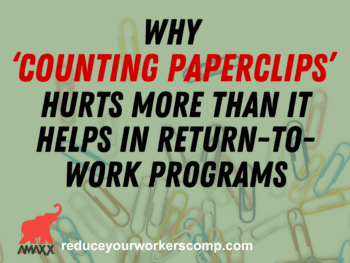Medical disability guidelines can assist an employer in planning for the future return of an injured worker. Medical disability guidelines are an essential planning tool because they provide an employer with a time frame as to how long an employee, on average, will be away from work. Large self-insured employers, TPAs, insurance companies as well as captives and associations that handle claims all use online medical duration guidelines.
Medical disability guidelines do not offer the medical provider or employer a precise number, but rather a range of time the guideline’s user can anticipate the employee will be off work depending by the difficulty of work. The range of time is based on a compilation of extensive data about numerous injuries. The collection of data is sorted by the nature and the extent of injury. The greater extent of data, the more accurate a disability duration prediction is. The field of occupational medicine continues to grow and expand, providing a constantly revolving and growing accumulation of data.
Click Link to Access Free PDF Download
“13 Research Studies to Prove Value of Return-to-Work Program & Gain Stakeholder Buy-In”
It should be noted that medical disability guidelines are designed to provide physicians, employers, and employees with ranges and guidance, not precise answers. Guidelines often have a minimum recovery time, a maximum recovery time, and an optimum/average recovery time. The specific employee’s willingness and inclination to return to work can be measured in three ways – restrictions, limitations, and the willingness to tolerate the symptoms brought on by the injury.
The medical provider will set the restrictions on what the employee should or should not do. While the employee may be capable of doing the activity, to do so could poses a risk to the employee and possibly others. For example: an employee with an injured arm might be capable of driving a dump truck, but there is risk the injury could impair the employee’s ability to do so, posing a risk to both himself and others.
The medical provider will also take into consideration limitations the employee has due to the injury. These limitations are often based on a capacity evaluation of what the employee is physically capable of doing and how long it should be before the employee should be capable. For example: an employee with an injured back will not have the physical capability to lift heavy objects. Limitations are normally in place for what would be considered the average time a person will be off work.
The restrictions closely conform to the minimum column of the medical disability guidelines while the limitations will often correlate with the optimum recovery time in the guidelines. The maximum amount of time an employee should be off work is reflected by the concept of tolerance.
The greatest variance in the medical disability guidelines arises from the willingness of the employee to tolerate the symptoms of the injury. The medical provider may look the medical disability guidelines and establish what is the normal recovery time for an injured person who has a particular nature and extent of injury. Individual factors such as fatigue and pain can impact an employees’ disability duration.
FREE DOWNLOAD: “13 Research Studies to Prove Value of Return-to-Work Program & Gain Stakeholder Buy-In”
Personal factors can also play a role in the recovery and disability duration. Any comorbidities the employee has (diabetes, obesity, etc.) can distort the disability duration. The employee’s motivation to return to work can influence the employee’s tolerance level. The motivational factors can include income (satisfied with the tax-free income of workers compensation), job dissatisfaction, self esteem, health insurance provided by the employer, etc. These are not medical reasons for disability but impact the employee’s willingness to tolerate injury symptoms, and therefore whether or not the employee disability duration falls within the medical disability guidelines. The maximum time frame is often placed at the 90 percentile where 90 percent of the people with the type of injury involved have returned to work.
The medical disability guidelines are evidence based disability durations. They are multidisciplinary in scope with their findings continuously undated to reflect improvement in medical care and medical practice. They are best used to answer the question “how long will the injured employee be off work.”
Author Rebecca Shafer, JD, President of Amaxx Risk Solutions, Inc. is a national expert in the field of workers compensation. She is a writer, speaker, and website publisher. Her expertise is working with employers to reduce workers compensation costs, and her clients include airlines, healthcare, printing, publishing, pharmaceuticals, retail, hospitality, and manufacturing. See www.LowerWC.com for more information. Contact: RShafer@ReduceYourWorkersComp.com
Our WORKERS COMP BOOK: www.WCManual.com
WORK COMP CALCULATOR: www.LowerWC.com/calculator.php
MODIFIED DUTY CALCULATOR: www.LowerWC.com/transitional-duty-cost-calculator.php
Do not use this information without independent verification. All state laws vary. You should consult with your insurance broker or agent about workers comp issues.
©2011 Amaxx Risk Solutions, Inc. All rights reserved under International Copyright Law. If you would like permission to reprint this material, contact Info@ReduceYourWorkersComp.com.
















